Report

Anne is a recent college graduate who lands a competitive position with a well-known multinational company. Brimming with confidence, she hopes to someday reach management’s top ranks. She does well in the first few years of her career and hits many of the early milestones to a C-suite role. As she gains experience at her company, however, doubts start to creep into her mind about whether she can handle the path ahead. Although her company’s board has articulated a desire to see more women in top management, the requirements to make it there seem daunting—and lonely. Her direct supervisors have little advice for her, and there are few women in upper management to serve as examples. Soon, Anne begins to make other plans for her life—plans that no longer include the C-suite.
For the past five years, Bain & Company has studied how and why women’s career paths differ from men’s. One of the more telling findings from our 2014 US gender parity research is that a significant number of women follow Anne’s prototypical trajectory. We surveyed more than 1,000 men and women in the US at all career levels, asking specifically about their interest in pursuing a top management position (board, CEO level, and one or two levels below CEO) in a large company. We discovered that 43% of women aspire to top management when they are in the first two years of their position, compared with 34% of men at that stage (see Figure 1). Both genders are equally confident about their ability to reach a top management position at that stage. This suggests that women are entering the workforce with the wind in their sails, feeling highly qualified after success at the university level. However, over time, women’s aspiration levels drop more than 60% while men’s stay the same. Among experienced employees (those with two or more years of experience), 34% of men are still aiming for the top, while only 16% of women are. As they gain experience, women’s confidence also falls by half, while men’s stays about the same.
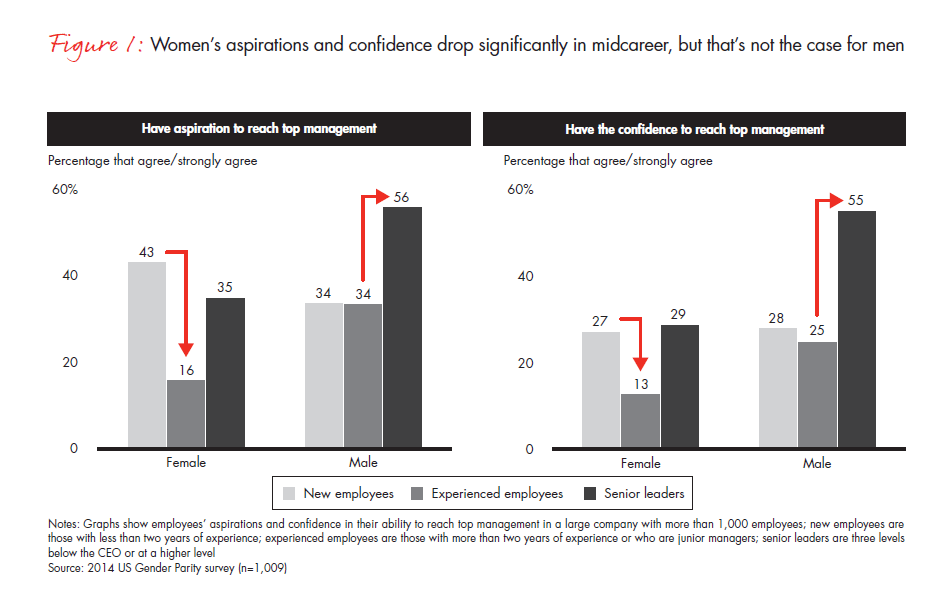
Many might assume this drop-off occurs as women get married and have children; however, our analysis suggests that marital and parental status do not significantly differ for women who aspire and women who don’t. The picture improves only slightly for more senior female employees. This detailed and segmented trend analysis runs counter to previous, more general research showing that women have aspirations equal to men’s.1
The result of this trajectory is a well-documented dearth of women in top management roles in America. Despite women comprising more than half of all college graduates2 and about 40% of MBAs,3 they number only a slim 5% of Fortune 500 CEOs and 17% of board members—numbers that have barely moved in decades.4
These statistics are more than just a sign that women are missing out on opportunities. For years, external research has shown the financial benefits that accrue to companies that promote gender equality.5 A commitment to gender equality can also help fuel employee engagement and higher corporate growth rates. Using the employee Net Promoter ScoreSM (eNPS) to measure employee engagement (see Figure 2), our research shows that eNPS is much higher than average for both men and women at companies perceived to offer each gender equal pay and promotion opportunities, while it is much lower than average at those not perceived in this way (see Figure 3).
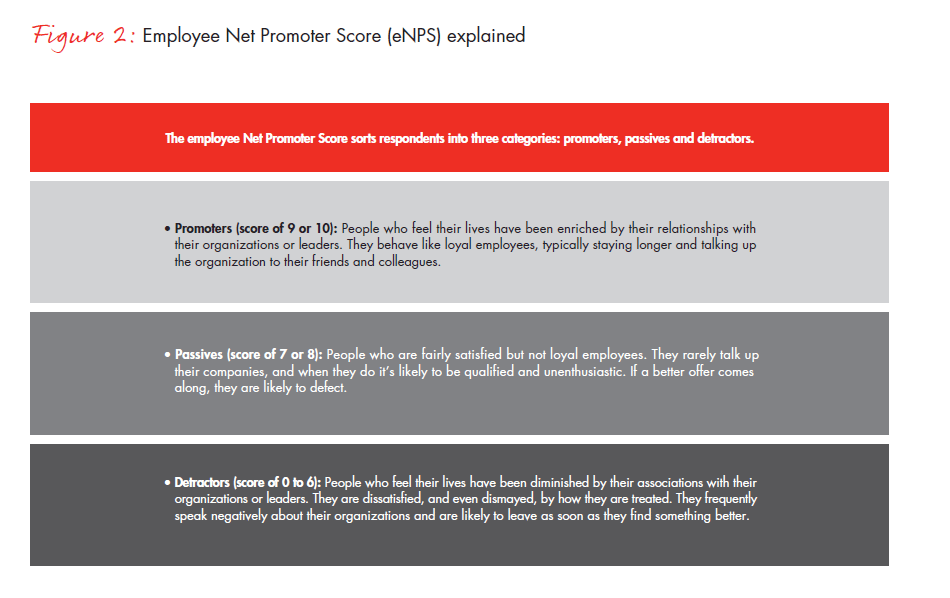
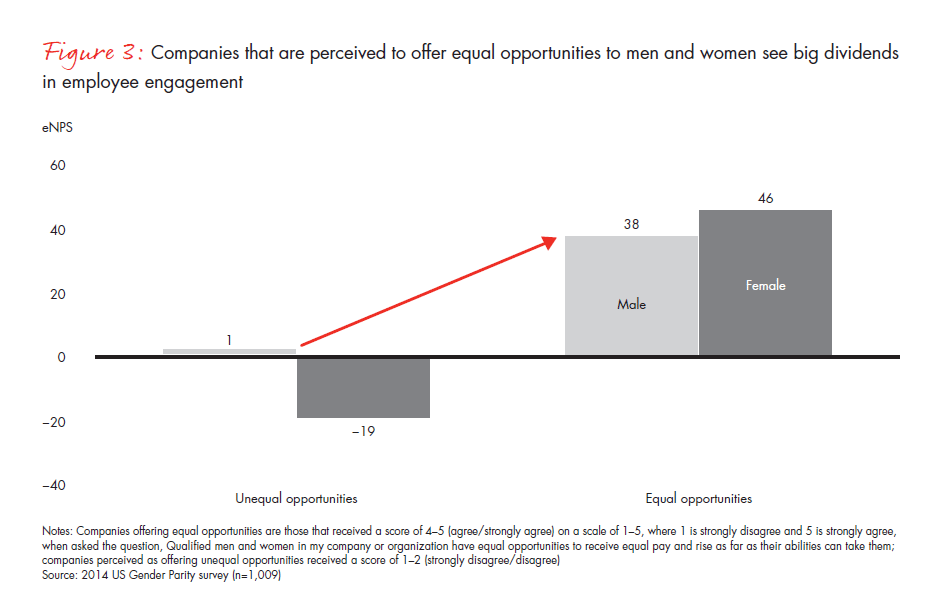
Previous Bain research showed that engaged employees create more customer promoters and better business outcomes.6 Outside research confirms this trend: One study showed companies with highly engaged employees grow as much as two-and-a-half times faster than those with low employee engagement.7
To date, efforts to spur change in gender equality typically have focused most heavily on two spheres of influence: the classroom and the boardroom. Classrooms—where women now are often in the majority—are becoming more conducive to and encouraging of women. This helps explain why women are more likely than men to aspire to leadership roles when they enter the workforce. In the boardroom, many senior leadership teams are investing time and resources on gender equality through corporate policies, programs and culture.
These efforts are necessary but not sufficient. While women graduate from the classroom with increasing levels of ambition, their classroom experiences do not always translate to the workplace. There, they often feel uncomfortable advocating on their own behalf: 40% of respondents believe that women undersell their experience and capabilities. And despite boardroom efforts, employees are not experiencing the full effects of the top-level commitment to gender equality: Only 35% of men and women believe the leadership team at their company or organization has made gender parity a visible priority.
Even taken together, the classroom and the boardroom have yet to truly level the playing field. Women, in particular, do not believe they have an equal opportunity to advance. Only 30% of women in middle management and 24% of women in upper management and executive positions believe there is an equal opportunity to be promoted on the same timeline as men, compared with 51% and 46%, respectively, of their male counterparts. These results indicate that there remains substantial room for improvement in gender parity outcomes.
While both classroom and boardroom efforts could improve, Bain research suggests that a major gap in gender parity advocacy and support exists at the conference room level, where employees spend the formative years of their career after school and before coming onto a board’s radar. For that reason, this report focuses on the daily interactions employees have with their supervisors during the career period in which they crystallize their aspirations and build—or erode—their confidence. We look not only at the direct interactions with supervisors but also at the stereotypes and environment a supervisor may help create or dispel.

The crisis of confidence: How women lose faith in their career opportunities
Men and women begin their careers equally confident about reaching top management, but women's confidence declines with experience. What can managers do?
1. Why women’s confidence and aspirations erode
One of this survey’s goals was to pinpoint the stage at which both men and women decide to disengage from an executive career path. What we learned is that half of the employees who do not aspire to top management made this decision as experienced employees, even if their doubts began building much earlier. The trend holds true for men and women. Among women who have made it to a top management position, 57% did not make the decision to pursue that route until they were an experienced employee more than two years into their career. Men’s decision points, however, are spread more evenly across age ranges, though 42% have already decided to aim for a top position before they are two years into their career.
Taken together, these findings suggest that an employee’s experience at work in the early years of their career shapes their choice to either pursue C-suite roles or stay behind. The obvious question is what factors drive women’s aspirations and confidence levels to fluctuate so dramatically, and so much more than men’s? To help answer it, we first identified key areas where the experiences of those who aspire to top management differ most from those who do not. We then dug deeper by looking at how likely both women and men were to agree with certain positive statements about their companies at various stages in their careers. Finally, we confirmed the findings by looking across career stages to see how significantly these factors influenced employee engagement as measured by eNPS.
Survey results point to three critical areas where women in the middle of their careers report more negative experiences and perceptions than those who have just entered the workforce: a clash with the stereotype of the ideal worker, a lack of supervisory support and too few role models in senior-level positions.
Clash with “ideal worker” stereotypes
Men and women start their careers feeling equally comfortable with traditional paths to the top, as measured by agreement with the following statement: “I see myself fitting into the typical stereotypes of success within my company” (see Figure 4). These new employees likely come into the workforce with bright-eyed optimism regarding the expectations of them and their ability to meet those expectations. But as employees—particularly women—gain more experience, they become significantly less confident about their standing. The data shows a sharp 39% decline between new and experienced women in feeling that they fit in, vs. 23% for men. While our study showed no significant difference in women’s aspiration levels based on marital status or motherhood, many employees still shift their priorities toward non-work interests later in their careers. “Many top-level execs are ‘on’ 24/7 and that is not appealing at all,” one survey respondent commented. More bluntly, “[I don’t want] to trade my personal life” to meet the organization’s demands, wrote another.
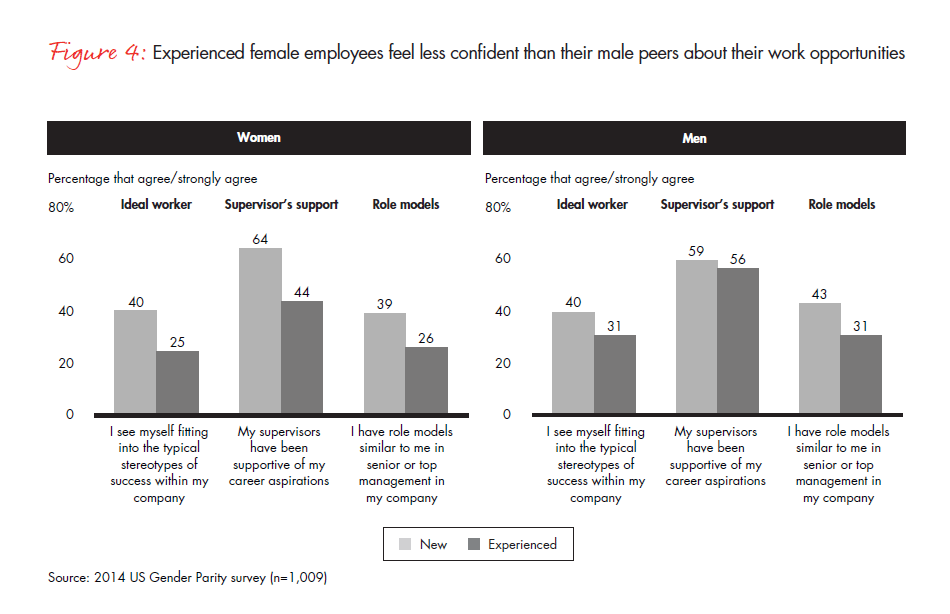
While companies may differ in many ways, there is broad acknowledgment of a deeply ingrained ideal worker model. When we asked survey respondents to rank the most important characteristics for promotion in their companies, approximately 60% agreed on the top five. These characteristics fell into two categories: maintaining a high profile in the organization, and an unwavering commitment to long hours and constant work (see Figure 5). To build their visibility, ideal workers are willing to take on high-profile projects on top of day-to-day work and are adept at self-promotion and networking. As the comments suggest, they also come in early, leave late and—in between—are “always on” via email or cell phone.
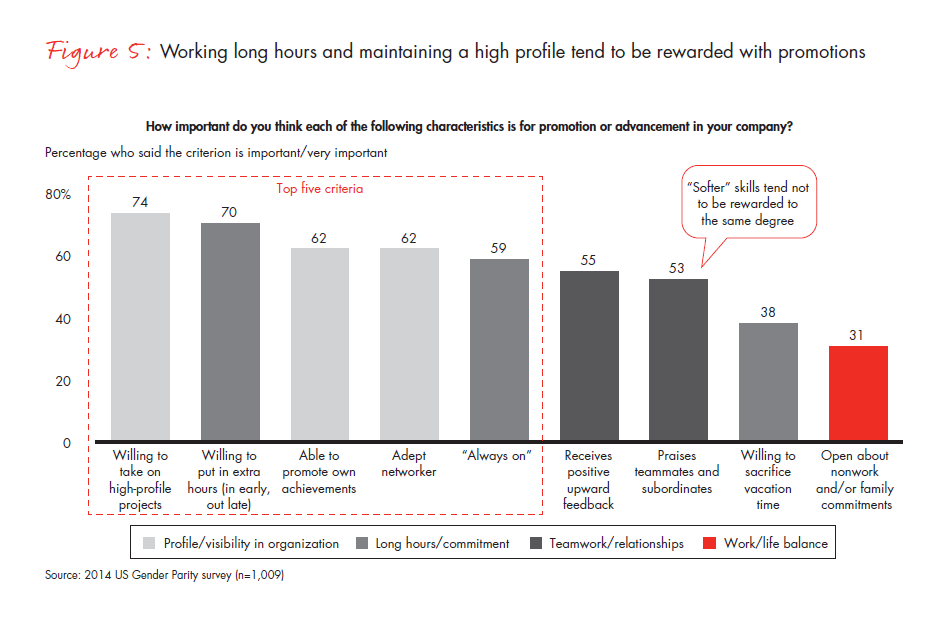
These ideal worker criteria are not necessarily the true keys to success, of course. More nuanced skills, such as the ability to juggle multiple priorities effectively or move a team to higher productivity may ultimately lead to better performance than merely spending more time at work. However, survey responses show that the ideal worker stereotype is still something with which ambitious employees must reckon.
Unfortunately, both men and women perceive these criteria as being particularly challenging for women to meet. In fact, women judge their own behavior most harshly. They are about twice as likely as men to believe both that women undersell their experiences and capabilities, and that women do not put themselves forward for challenging roles and assignments. The perception that women aren’t as committed to long hours because of their family commitments is also common, with a sizeable 58% of women and 47% of men believing that managing both work and family commitments slows or disrupts women’s careers.
The dominance of these ideal worker stereotypes affects employee engagement more than any other factor measured against eNPS in the survey (see Figure 6). Employees at companies that are perceived to embrace many paths and career models are substantially more engaged than average, with men’s eNPS at these companies two times the male average and women’s three-and-a-half times the female average. On the other hand, those who do not feel their companies embrace many paths and career models have significantly lower eNPS. In fact, women’s eNPS is a staggering 98 points lower at such companies, vs. at firms that prioritize equality.
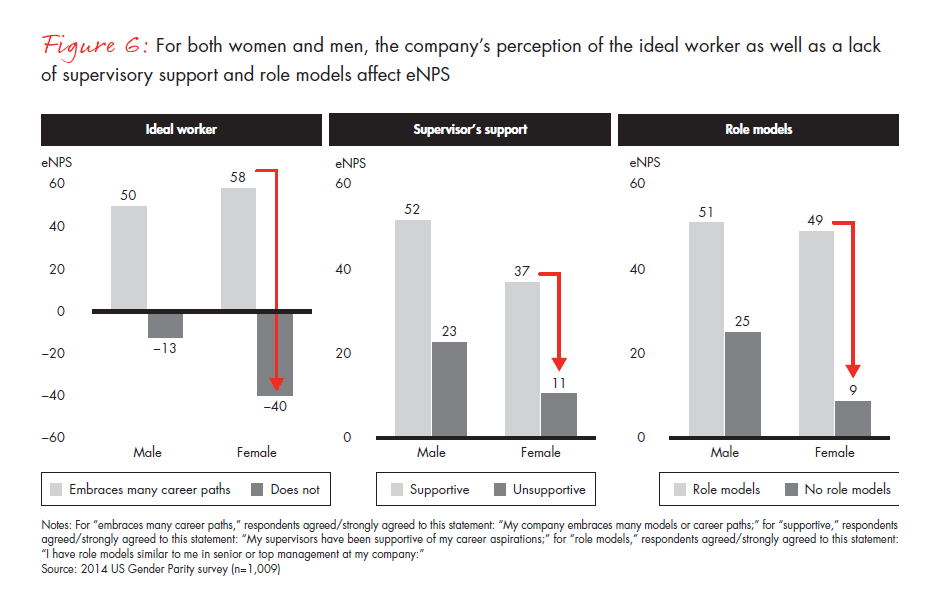
Lack of supervisory support
The second characteristic of women with work experience who have lost their aspirations for C-level roles is feeling unsupported by supervisors. New female employees are more likely than new male employees to agree with the statement, “My supervisors have been supportive of my career aspirations.” But by midcareer, the picture looks very different (see Figure 4). Experienced women’s agreement level is about one-third lower than new women’s, while men’s barely moves. This suggests that whatever is happening in the conference room reinforces men’s aspirations while eroding women’s. Employee loyalty also suffers when supervisors are not tracking with an employee’s career ambitions. Across career stages, those who do not feel they have a supportive supervisor have significantly lower eNPS than those who do (see Figure 6).
One reason for the disconnect between midlevel women and their (often male) supervisors may be a lack of meaningful dialogue. In fact, one study showed that almost two-thirds of male executives are hesitant to have one-on-one meetings with a more junior woman.8 And even when dialogue occurs, gender differences may affect the nature and success of the conversations. For example, women are often seen as more relational while men are often seen as more transactional. Survey respondents are two-and-a-half times more likely to believe men are worse at building relationships with colleagues than women. Respondents are five times more likely to believe women are better at working with colleagues of the opposite gender. The upshot is that female employees may need a different type of dialogue than male supervisors are accustomed to having.
Whatever the root cause, many women believe their supervisors don’t know where they are in their career aspirations, or what to say or do to support them. Some are frustrated that their supervisors are “not encouraging or recognizing a desire to stay and passion for the work,” as one survey respondent says. Others report receiving poorly delivered and often very negative feedback from supervisors: that they “lacked talent”; that they’re “not cut out for” a role in top management; or simply that they “didn’t really want it.”
Too few role models
Finally, survey responses from experienced women indicate that the dearth of women in upper management to serve as role models also hampers progress toward gender parity. While both experienced men and experienced women are less likely to feel they have role models similar to themselves than new employees, the difference is slightly more significant for women. Combined with women’s perceived inability to meet the ideal worker norm and lack of supervisor support, the three factors form a psychological barrier that can be difficult to overcome. Those who do not feel they have role models in their companies also have significantly lower eNPS than those who do, again with the difference being more pronounced for women (see Figure 6).
One of the paradoxes surrounding the push for role models is that there are not yet enough women at the top to embody the heterogeneity of the employees looking up to them. In fact, many of these women face undue pressure to be all things to all people, potentially detracting from their ability to focus on their own career growth. A woman with particularly low eNPS states that she would not recommend her company: “There are very few women at the senior executive level who provide groundbreaking leadership and can serve as role models for future leaders.” On the flip side, many companies fail to use the legitimate examples their current leaders—male and female— could provide to up-and-comers who crave a broader set of stories. For example, our research shows that 64% of female executives and 47% of male executives at large companies have used flexible work arrangements. Unfortunately, stories of how leaders made tradeoffs between work and personal life on their way to the top are often not shared broadly. This muting effect is consistent with the ideal worker characteristics described earlier where the characteristic that ranks lowest is being open about family and nonwork commitments.
2. How to build women’s confidence and aspirations
Previous Bain research has shown the extent to which a direct supervisor can shape an employee’s corporate experience. One group of studies suggested that direct supervisors—rather than HR or leadership teams—fundamentally drive employee loyalty and engagement. The correlation is significant: 87% of employees who are “promoters” of their companies also give their direct supervisors high ratings.9
Despite the vital nature of these supervisory relationships, however, leaders on the front line are often unsure about the expectations for developing their employees, much less how to provide the level of support and professional development their employees need. It’s not uncommon for managers to win promotions because they have functional expertise, rather than strong management or people development skills. Further, financial goals typically give an incentive to midlevel managers to achieve results, with people-related outcomes a distant second priority.
To make meaningful progress on gender parity goals—and indeed to more effectively lead the next-generation workforce—frontline managers must rethink and reinvigorate their efforts in the conference room to catalyze the talent and ambition in their ranks that may otherwise go unappreciated (see Figure 7). At the corporate level, companies must support these efforts by setting expectations that all leaders are responsible for encouraging and developing female talent, and by providing the necessary training or policies to make those expectations a reality.
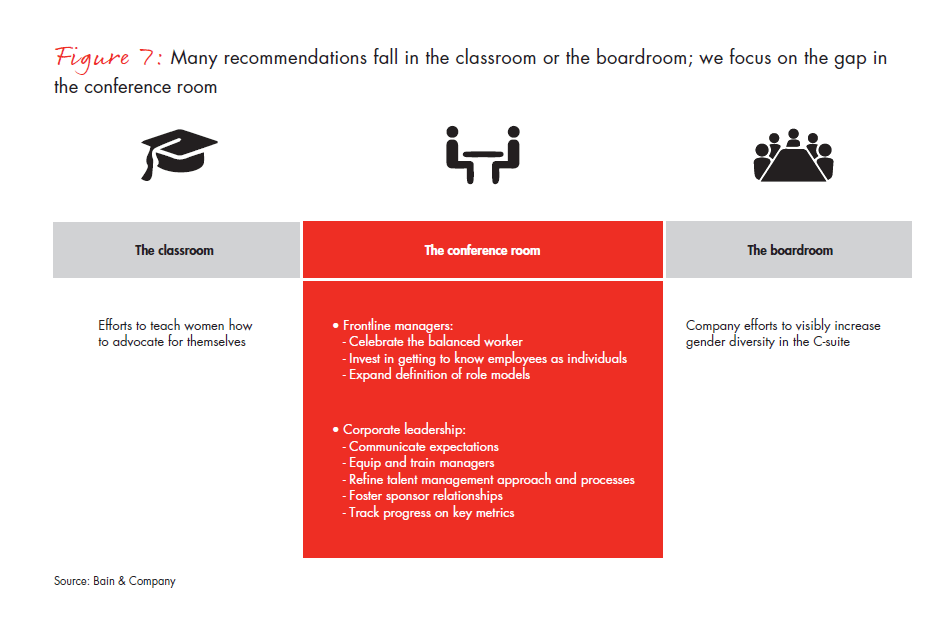
Based on our research, we offer a number of practical recommendations for both managers and corporations, as follows.
Advice for frontline managers: Creating change in the conference room
From the big decisions of whom to promote to the smaller choices about whom to champion in a team meeting, managers can shift employees’ standings in significant ways. (See below, “Five daily conference room actions for any frontline manager.”) Managers are not just power makers; they also have the most direct access to employees and their personal goals and challenges. With this combination of power and knowledge, there are many actions managers can take to ensure they are equipped to more effectively encourage, develop and support their female employees:
Celebrate the balanced worker. Managers can strongly influence their employees’ view of the ideal worker, both in terms of their own behavior and in what they outwardly reward and champion. To encourage a healthier work-life balance among employees, managers should consider sharing some of the specific ways in which they personally integrate their work and home priorities, and encourage employees to experiment with those and other tactics, such as blocking out certain hours each day to attend to family commitments or in some cases working from home. Managers should also be hyper-aware of who is selected for the most visible roles (e.g., emceeing a department meeting, presenting at a team meeting) to make sure opportunities are well distributed. Finally, spotlight those who have excelled using alternative work models through such vehicles as newsletter articles, corporate videos and live events. Mining these stories can help create more common ground between leaders and employees, and can also help fuel more creative solutions for future generations.
Invest time in getting to know employees better as individuals. When a manager directly engages with an employee about their career goals and how to achieve them, they often see multiple benefits at once. First, the employee is likely to feel more valued and more ambitious as a result of being asked. Second, the manager has more fodder to consider in helping the employee develop and add value to the organization. Yet starting those conversations is not always easy. The two key aspects of the process to master are how to elicit the necessary information and what to do with it.
How to facilitate sensitive conversations. While it may be difficult to bring up potentially sensitive topics, managers can take several steps to make the process easier. Schedule regular meetings so that dialogue becomes more comfortable; find a neutral meeting spot such as a conference room or coffee shop; and be prepared (and willing) to step outside of comfort zones.
Consider how to tailor support to the individual. Employees hold a wide range of career aspirations, some of which may change as they move through different career stages. One of the toughest jobs for a manager may be figuring out who wants what and when, and tailoring their support accordingly. Women’s states of aspiration are not always obvious to the outside world and can change over time. For managers, the key point is to bear in mind that successfully supporting an employee can look very different from one person to another and over time. Open dialogue, listening, and adjusting tactics based on employee feedback are vital to making support meaningful. What doesn’t work is taking a one-size-fits-all approach.
Employees will always need both tactical and emotional support, but may index toward one or the other depending on their preferred style, current career aspirations, position and more. For example, when a woman is pushing to top management, she may need more tactical support, such as clearly outlined criteria for promotion, specific and actionable performance feedback, being asked to lead a special project, and direct affirmation and encouragement that she can reach top management. But her needs may change as her career aspirations shift or as family commitments change, requiring more emotional support. Action items for managers in this category include seeking out and listening to feedback from employees, establishing a genuine personal connection with them, publicly praising a woman for a job well done, and encouraging and supporting a woman to use non-traditional working models—assuming this is support she wants. Managers can inspire and encourage employees by tailoring these actions to each individual employee based on her specific needs and preferences.
Men and women start with similar career ambitions, but women's confidence in their ability to reach top executive positions falls more quickly than men's. Women often fail to find role models at their companies or think they don't fit the stereotypical image of success. In many cases, managers don't encourage women to take necessary career risks. Bain Partner Julie Coffman shares some tactics that could help companies reverse this trend.
Expand the concept and definition of role models. While many often assume that finding role models is a purely organic activity on the part of the individual, supervisors can in fact meaningfully influence the process. Frontline managers may not always be their employees’ role models, but they can play an important role in helping employees understand why role model “composites” are helpful and how to engage with them.
How role models fit. Role models have historically been seen as single individuals who look like the person needing a role model. That is, a woman often selects a female role model, a man chooses a man, alumni from the same university tend to band together, and so on. However, it is important for supervisors to help employees understand that many people can offer relevant stories and solutions, regardless of demographic category.
Moreover, managers can help redefine the notion that up-and-coming employees need only one role model, since it is nearly impossible for a single person to embody the right combination of traits. Instead, employees might find their best source of inspiration from creating a role model portfolio that includes different individuals with certain traits and experiences around issues like work-life balance or leadership styles that might resonate with them at different points in their career. This group can be a critical part of an employee’s “personal board of directors,” providing advice and experience.
Identifying good role model candidates. Managers often know many more people across the organization than their employees and can serve as a critical conduit for connecting women with the right role models at the right times. However, this can only happen if managers have open dialogues with women and understand specifically what they might need modeled at a given time. These dialogues might also create opportunities to coach certain male leaders on how to be good role models. In fact, managers should resist the urge to only connect female employees with female role models, in part to reduce the pressure on those (likely few) female role models.
Advice for corporate leadership: Supporting efforts in the conference room
Many companies have a variety of thoughtful initiatives designed to increase the number of women in top roles, such as flexible work arrangements, networking groups or formal mentorship programs. Even with strong support from the top, however, many initiatives fail to thrive when they hit the daily pressures on the front lines. Companies can improve by eliminating the assumption that someone else in another part of the business is handling gender parity. This requires efforts to translate high-level goals into practical, everyday actions for frontline leaders that reinforce, rather than squelch, the confidence women bring into the workforce. Here we look at several ways corporate leaders might make change in the conference room a reality:
Communicate expectations across the organization. The message that gender parity is important needs to start with the CEO and cascade down through top leaders. Everyone needs to know that this mission is important to their individual bosses, not just the nebulous boardroom. Male leaders in particular may be surprised to realize they can do an important service by sharing the workload often placed on female leaders to own “women’s initiatives.”
Equip and train managers with the capabilities required to meet these expectations. Most managers are not equipped to coach and develop employees, so offer skill-building and training opportunities to address the biggest gaps in existing manager capabilities. These trainings should address the particular ways they can coach and inspire women, with thoughtful dialogue and role-playing exercises to underscore the complexity of the task. It is particularly important that male managers be consciously included in these trainings and reminded of the importance of the role they play in supporting their female employees.
Refine approach and processes to recruiting and talent management. From hiring to promotions to people leaving the organization, make sure the organization has the necessary data to understand what’s happening to its own talent pipeline. Where are the victories, and where are the biggest challenges? What segments of the population might be underrepresented, and what can help right these imbalances? In addition to collecting important data, hire and promote candidates who break the mold with nontraditional career paths or who are uniquely skilled at supporting employees and unlocking their talents. Moreover, aim to include people with diverse experiences and styles in the decision-making processes for hiring and promotion so they can more adequately reflect new perspectives on the ideal worker.
Foster sponsor relationships among senior-level employees and ambitious up-and-comers. A sponsor advocates for the future of the individuals they assist, helping to open doors and introduce new opportunities to them (unlike the private counsel a mentor might provide).10 Creating this type of interaction can benefit an organization for a variety of reasons, including the proactive succession planning it promotes. Senior-level employees can go a step beyond the necessary exercise of considering who should replace them and actively help that person (or people) to be ready for the role. To accomplish this, sponsors must have power in their organizations and be a part of the conversations about employees’ futures and opportunities. Given the small number of females in many of these powerful roles, men are often a critical part of the sponsorship equation. As one female respondent said, “Women need a male sponsor to get ahead.”
Implement and track progress on key metrics. Hold managers accountable for supporting employees by creating metrics around key people-development skills and by regularly engaging with managers on their progress in these areas. Whether through formal or informal feedback, find out what employees think of their managers and what might be missing. Regularly comparing team outcomes across the organization can help shine a light on managers who are particularly successful and encourage behavior change among those who are not. Additionally, consider tracking broader metrics such as employee turnover or the number (or percentage) of women in key roles within a manager’s sphere of influence.
If there is one action item that leaders at all levels—both corporate and frontline—should take to heart, it’s the power of encouragement. Women are entering the workforce with plenty of ambition and confidence; leaders must help them grow rather than wither. While the right way to accomplish this varies significantly across situations and requires tailoring to individuals, managers who personally take on the challenge of gender parity—and companies that mobilize resources to support those managers—stand to see impressive results.
3. Conclusion
Increasingly, Anne’s experience that we described earlier—a clash with the traditional corporate culture that results in a nosedive in confidence and ambition—is likely to resonate with both male and female employees. The generation now entering the workforce is particularly attuned to personal missions and highly unlikely to feel comfortable with cookie-cutter approaches to promotions or long hours in the office. Our study shows that 45% of those under the age of 30—more than any other age group—envision a career that allows for periodic breaks. This finding reinforces other research indicating a generational shift in how both men and women view work.11 As a result, managers who can help employees overcome their discomfort in the corporate environment and successfully chart their own unique paths will become very valuable to organizations.
As career expectations between men and women continue to converge for the next generation of employees, companies have to get the gender parity issue right to stay ahead of the curve in their talent management practices. This is no easy feat. The imbalance of women in power is a challenging issue laden with complexity and nuance. We’ve discovered, however, that everyday interactions make a huge difference in gender equality outcomes. Classrooms and boardrooms will continue to be important crucibles for change, but by themselves they are insufficient. The conference room, where teams interact and professionals grow, is a vital additional place for progress. Our research suggests that by encouraging and enabling frontline managers to rethink their approaches to women’s career development, companies will be far more successful in attracting and retaining the next generation of top talent, both female and male.
For more information about the methodology of this report, see the PDF version.
Five daily conference room actions for any frontline manager
- Set an example for your employees by being open about your own path to success and by getting to know them personally.
- Visibly reward and outwardly champion employees who break the mold, offering public recognition for those who are successful using non-traditional schedules or career paths.
- Facilitate open discussions with your employees about their career aspirations, listen intently and co-create strategies for how you can best support them in reaching those goals.
- Be an advocate for your employees. Find opportunities for them to grow in the organization through such avenues as recommending them for promotion, assigning them high-profile projects and prompting them to raise their own hands for step-up opportunities.
- Connect women to a variety of high-potential role models, regularly refreshing the connections as the employee’s needs and focus change over time.
Julie Coffman is a partner with the Bain Chicago office and is a leader in both the Global Healthcare and Organization practices. She is also chair of Bain’s Global Women’s Leadership Council. Bill Neuenfeldt is a Bain partner, head of the New York office and a leader in the firm’s Strategy and Private Equity practices.
Net Promoter SystemSM and Net Promoter ScoreSM are trademarks of Bain & Company, Inc., Fred Reichheld and Satmetrix Systems, Inc.
1 Eileen Patten and Kim Parker, “A Gender Reversal On Career Aspirations,” Pew Research Center’s Social & Demographic Trends, April 19, 2012.
2 The Condition of Education, US Department of Education, National Center for Education Statistics, 2012.
3 Joseph Mondello, “The Numbers Game,” Association to Advance Collegiate Schools of Business (AACSB), April 30, 2014.
4 Pyramid: US Women in Business, Catalyst, New York, May 1, 2014.
5 The share prices of companies with at least one woman on the board outperformed those with no women on the board, according to a 2012 Credit Suisse report, Gender diversity and corporate performance. Also, equity and return on invested capital were significantly above average at firms that had three or more women on their board, based on a 2007 Catalyst report, The Bottom Line: Corporate Performance and Women’s Representation on Boards.
6 Jon Kaufman, Rob Markey, Sarah Dey Burton and Domenico Azzarello, “Who’s responsible for employee engagement?”, Bain & Company, December 2013.
7 William Werhane and Mark Royal, “Engaging and Enabling Employees for Company Success,” Hay Group, October 2009.
8 Sylvia Ann Hewlett, Kerrie Peraino, Laura Sherbin and Karen Sumberg, The Sponsor Effect: Breaking Through the Last Glass Ceiling, Harvard Business Review research report, January 2011.
9 Jon Kaufman, Rob Markey, Sarah Dey Burton and Domenico Azzarello, “Who’s responsible for employee engagement?”, Bain & Company, December 2013.
10 Sylvia Ann Hewlett, Kerrie Peraino, Laura Sherbin and Karen Sumberg, The Sponsor Effect: Breaking Through the Last Glass Ceiling, Harvard Business Review research report, January 2011.
11 Joan Blades and Nanette Fondas, The Custom-Fit Workplace, John Wiley & Sons, 2010. Stewart D. Friedman, Baby Bust: New Choices for Men and Women in Work and Family, Wharton Digital Press, 2013.






